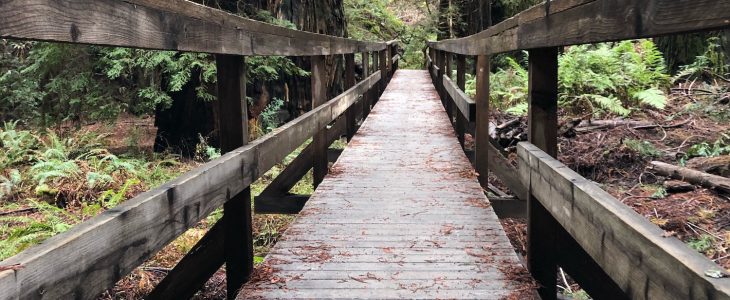
Most of us don’t have space in our gardens for the world’s largest tree. And some recommend against planting one due to thirsty shallow roots. But in a landscape where there is plenty of space and water, coast redwood Sequoia sempervirenscan be used as an evergreen screen or to create a shady grove for a cool retreat on a hot summer day. If you have a spot with existing redwoods you are likely familiar with the shady moist microclimate created by summer fog-drip from sheltering evergreen branches. Leaf litter provides mulch, suppressing weeds and enriching the soil. This is an ideal spot for redwood sorrel Oxalis oregana, wild ginger Asarum caudatum, redwood violet Viola sempervirens, slim Solomon’s seal Maianthemum stellatum, and fairy bells Prosartes spp. to name a few redwood loving perennials.
Growing within 35 miles of the coast along creek bottoms and on north facing slopes of canyons from Big Sur to the western edge of the Klamath Range on the California Oregon border, coast redwood trees defy everyday norms of scale in both size and time. The current tallest known Sequoia sempervirens is a 380-foot giant named Hyperion growing at an undisclosed location in Humboldt County. These trees require warm wet winters and cool foggy summers, under ideal conditions a coast redwood can live up to 1000 years. They are well adapted to withstand the vicissitudes of life in California, responding to periodic flooding by growing new roots from adventitious buds, and resistant to fire by sporting a coat of thick fibrous bark that is low in flammable pitch. Of course, thick flame-resistant bark protects trees from not too hot ground fires – the catastrophic crown fires we have seen in the past few years have been too hot for even these incredible plants.
Walking in the understory of a redwood forest on thick layers of leaf litter sound is absorbed. The hush underlines a sense of awe. Wide girthed single trunks rise straight skyward with a slight twist of red brown bark. The lowest branches are far enough up that your head tips back to catch a glimpse in dizzying wonder. Here in the San Francisco Bay Region’s East Bay we find second and third growth stands in familiar places such as Oakland’s Sausal Creek and Berkeley’s Strawberry Creek watersheds. At the headwaters of the Sausal Creek watershed pre-logging era giants stood so high they were used as navigational points to guide early mariners safely through the mouth of the SF Bay.
Even if you can’t justify planting a redwood, I hope you are able to take the time to visit a redwood forest. Near the time of Winter Solstice, the days are startlingly short, and cool and moist. These conditions always seem to me to grant permission to take a hibernation break. What better time to visit and enjoy trees that were here long before us!
Thank you all for your support,
Happy Winter Solstice 2021
Kristen Hopper